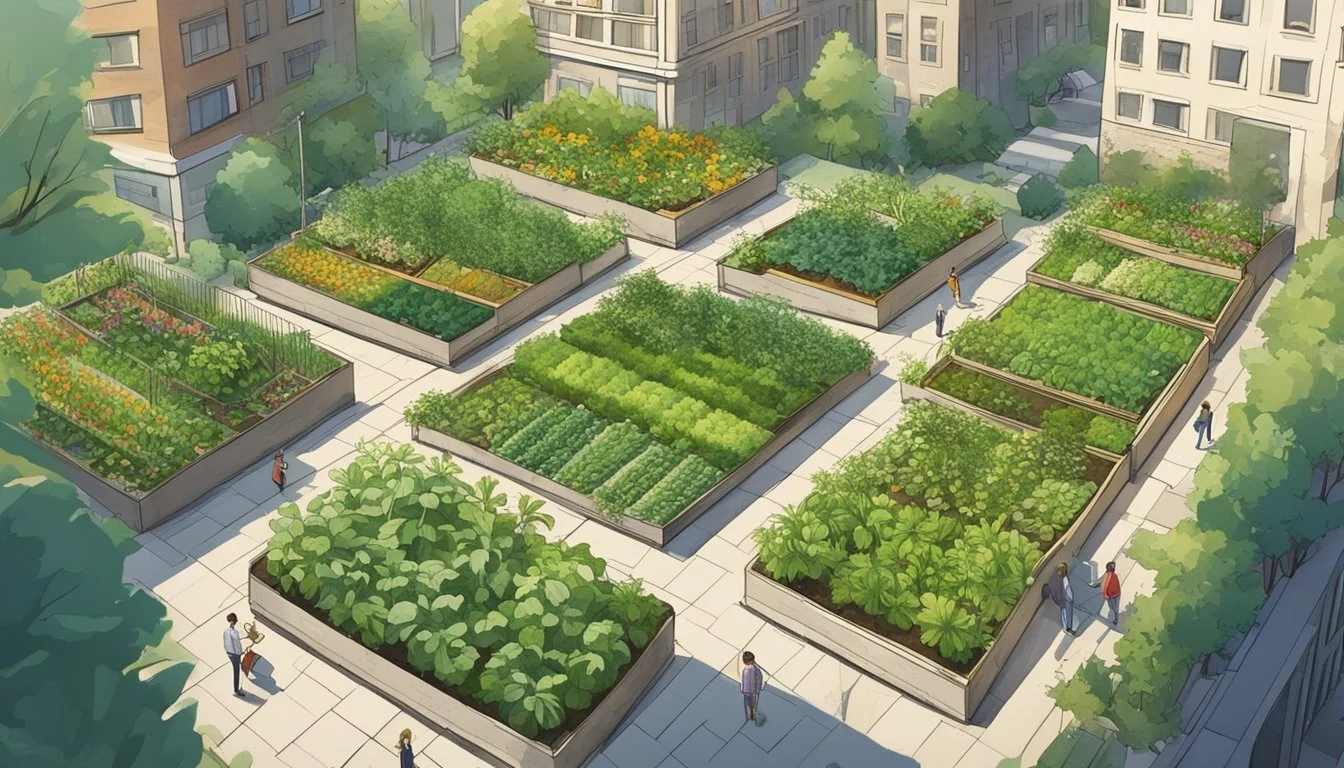Free Land for Community Gardens
Urban Agriculture Transforming Cities
Urban agriculture has seen a significant rise in popularity. Cities across the country are witnessing a surge in community gardens and urban farms. These green spaces not only offer a source of fresh produce but also foster community bonds and contribute to environmental sustainability.
Obtaining free land for community gardens can be a game-changer for urban agriculture enthusiasts. Many city initiatives and programs are designed to support these endeavors, making it easier for residents to transform vacant lots into flourishing gardens. Programs often include resources, educational support, and sometimes even grants, ensuring that urban farmers can thrive.
The impact of community gardens extends beyond just individual benefits. By cultivating urban spaces, these gardens help reduce food deserts, promote healthy eating, and bring diverse communities together. As more people embrace this movement, the transformation of urban landscapes into productive green spaces continues to grow.
Historical Background of Urban Agriculture
Urban agriculture has deep roots, reflecting a blend of historical influences and modern necessities. Significant development can be traced back to policies established by influential leaders.
A Legacy from President Abraham Lincoln
President Abraham Lincoln's establishment of the Department of Agriculture in 1862 greatly impacted urban farming. This move aimed to support agricultural development and address food security, laying the groundwork for modern urban agriculture initiatives.
Federal property was later utilized for community gardening, reflecting a commitment to public access to land for food production. Contemporary urban farms owe part of their existence to these early efforts, demonstrating a long-standing tradition of integrating agriculture into urban spaces.
Understanding Community Gardens
Community gardens are integral to urban agriculture, facilitating local food production and strengthening community ties. These gardens offer fresh produce, enhance food security, and provide educational and social benefits to urban residents.
Definition and Core Concepts
A community garden is a shared space where individuals collaborate to grow fresh produce. These gardens are usually located in urban areas and can be managed by local organizations, municipalities, or dedicated volunteer groups. The core concept revolves around collective effort, shared resources, and community engagement. Participants typically share gardening tasks, maintenance, and the harvest. Many gardens also serve as educational hubs, teaching sustainable gardening practices and promoting environmental stewardship.
Types of Community Gardens
Community gardens come in various forms, each catering to different needs and resources:
Neighborhood Gardens: Plots are rented or assigned to individuals or families.
School Gardens: Integrated into educational settings to teach children about agriculture and nutrition.
Therapeutic Gardens: Designed for therapeutic purposes in hospitals or senior centers.
Rooftop Gardens: Utilize rooftops of buildings to maximize space in densely populated areas.
Demonstration Gardens: Showcase best gardening practices and innovations.
Each type serves a specific purpose, whether providing food, education, or therapy, and can vary greatly in size and scope.
Role in Local Food Systems
Community gardens play a vital role in local food systems by improving access to fresh produce and bolstering food security. They reduce reliance on imported food and minimize the food miles associated with transportation. By growing food locally, these gardens contribute to a sustainable urban environment. They also promote biodiversity and soil health through organic practices. Furthermore, community gardens foster social connections and encourage community engagement, making them crucial assets in urban planning and development.
Benefits of Community Gardens
Community gardens provide multiple benefits, enhancing urban life by offering environmental, social, and health advantages. These gardens reduce the carbon footprint, foster social connections, and improve access to nutritious food.
Environmental Advantages
Community gardens help in reducing the urban heat island effect. They increase green spaces in cities, contributing to improved air quality by absorbing pollutants and carbon dioxide. Additionally, these gardens reduce food miles, as the produce is grown locally. This local cultivation helps lower greenhouse gas emissions associated with transportation.
Urban gardens often employ sustainable practices such as composting organic waste, which enriches the soil and reduces the need for chemical fertilizers. Moreover, they contribute to biodiversity by providing habitats for beneficial insects and birds. This biodiversity is crucial for a balanced and healthy ecosystem.
Social and Community Benefits
Community gardens foster community engagement and social connections. They provide a communal space where people can work together towards a common goal, enhancing social cohesion. These spaces often host educational programs and workshops, teaching participants about sustainable agriculture and healthy eating.
Gardens can bridge gaps between diverse community members, creating a sense of belonging and mutual respect. They also offer a productive use of vacant land, turning potentially neglected areas into vibrant community hubs. These activities often result in strengthened community networks and safer neighborhoods.
Health and Nutrition
Access to fresh, nutritious food is one of the primary benefits of community gardens. These gardens allow urban residents to grow their own fruits and vegetables, which can lead to improved dietary habits. Fresh produce harvested from community gardens is typically more nutritious than store-bought options, as it is often consumed shortly after harvesting, retaining more vitamins and minerals.
Engaging in gardening activities provides physical exercise, which contributes to overall health and well-being. It also offers mental health benefits by reducing stress levels and promoting relaxation. Community gardens can contribute significantly to food security, ensuring that even low-income families have access to healthy food options.
Setting Up a Community Garden
Establishing a community garden requires meticulous planning, from finding suitable land to understanding legal zoning regulations and designing necessary infrastructure. Here are crucial steps to ensure a successful garden setup.
Finding and Assessing Land
To start, identifying suitable land is essential. Evaluate locations for accessibility, sun exposure, and soil quality. Vacant lots, unused public spaces, and school grounds are common choices. Conduct soil testing to check for contaminants and fertility since urban soils can contain heavy metals. Partnering with local land trusts or city programs can provide free or low-cost land options for community use, making land access less burdensome.
Legal Considerations and Zoning
Navigating legalities is crucial. Research local zoning laws to ensure compliance. Some areas may require specific permits for gardening activities. Depending on the city, certain spaces might be zoned exclusively for agricultural purposes, while others may have strict usage guidelines. Obtaining permits, if necessary, involves submitting detailed plans and possibly attending zoning board meetings. Secure liability insurance to cover accidents and state-specific agricultural regulations.
Design and Infrastructure
Designing the garden involves creating a layout that maximizes space and functionality. Begin with a simple site map to scale, identifying key elements like planting beds, pathways, and storage sheds. Water access is critical: ensuring a nearby water source or installing a rainwater harvesting system. Infrastructure can include raised beds for better soil management, fencing to protect from animals, and compost bins. Involve community members in planning to ensure shared vision and sustainability.
Proper design and infrastructure lay the foundation for a successful, productive community garden that meets the needs and expectations of all involved.
Managing Urban Agriculture Projects
Effective management of urban agriculture projects requires addressing various challenges. These include navigating urban obstacles, ensuring adequate water resources, and dealing with soil quality issues.
Overcoming Urban Challenges
Urban farms face unique obstacles such as limited space and development pressures. Managers need to be strategic in land use, often opting for vertical farming or rooftop gardens.
Engaging with the community can provide support and safeguard against potential redevelopment. Collaboration with local authorities and organizations can also secure long-term stability for these projects.
Water Management and Resources
Water is crucial for urban agriculture, and managing it efficiently is vital. Urban farms can conserve water by utilizing drip irrigation or collecting rainwater.
Implementing sustainable practices reduces reliance on municipal water supplies. Urban farms may also explore greywater systems, which reuse water from sinks and showers for irrigation purposes.
Soil Quality and Contamination Issues
Soil contamination is a significant concern in urban agriculture. Testing soil for pollutants is essential before starting any project. Managers should prioritize using raised beds or importing clean soil to mitigate contamination risks.
Regular monitoring and maintaining healthy soil through organic amendments, such as compost, ensure safe and productive cultivation. Urban farmers must remain vigilant and proactive in addressing soil quality.
Fostering Education through Agriculture
Urban agriculture offers significant educational opportunities, promoting hands-on learning and connecting the community to sustainable practices. By focusing on educational programs and engaging youth, community gardens can instill essential skills and values.
Educational Programs and Workshops
Community gardens can host educational programs and workshops to teach essential agricultural skills. These activities include planting techniques, composting, and water management. Workshops can vary in focus, providing specialized knowledge such as organic farming or hydroponics.
Interactive sessions allow participants to understand the science behind sustainable practices. Educators and experts from urban farms often lead these initiatives, ensuring accurate and practical knowledge is shared.
Providing access to resources such as tool libraries and seed exchanges can further enhance learning. Partnerships with local agricultural organizations can facilitate guest lectures and specialized courses.
Engaging Schools and Youth
Involving schools and youth in urban agriculture fosters early exposure to environmental stewardship. School programs can integrate garden-based learning into curriculums, covering subjects like biology, ecology, and nutrition.
Field trips to urban farms offer students practical experience and a break from conventional classroom settings. Hands-on activities, such as planting and harvesting, engage young minds and develop an appreciation for nature.
Mentorship opportunities for older students can include managing mini-projects within the garden, enhancing leadership skills, and community involvement. Collaborations with educational institutions ensure these programs are structured and impactful, promoting long-term benefits for the youth and the community.
Economic Aspects of Urban Farming
Urban farming presents several economic opportunities that can be beneficial to city residents. These include securing funding for projects and effectively marketing and selling local produce.
Funding and Financial Resources
Securing financial resources is essential for urban farming initiatives. Cities often provide grants and subsidies to support community gardens. Nonprofit organizations also contribute by offering grants or low-interest loans.
Corporate partnerships can be another source of funding. Companies interested in corporate social responsibility may invest in urban agriculture projects. Additionally, crowd-funding platforms enable communities to raise money directly from individuals who support local food production.
Key Sources of Funding:
City grants and subsidies
Nonprofit organization grants
Low-interest loans
Corporate partnerships
Crowdfunding platforms
Marketing and Selling Local Produce
Local produce from urban farms can be sold directly to consumers, providing fresh food options and supporting local economies. Farmers' markets are popular venues for selling urban farm products. These markets not only provide a sales avenue but also enhance community engagement.
Community-supported agriculture (CSA) programs allow consumers to subscribe to receive regular produce deliveries. Urban farms can also form partnerships with local restaurants and grocery stores to supply fresh produce.
Key Selling Strategies:
Farmers' markets
Community-supported agriculture (CSA) programs
Partnerships with local restaurants and grocery stores
Effective marketing strategies include using social media platforms to reach potential customers and hosting community events to raise awareness about the locally grown produce.
Innovations in Urban Agriculture
Urban agriculture has seen significant advancements with the incorporation of technology and creative farming methods. These innovations are helping to maximize space, boost productivity, and promote sustainable practices in urban environments.
Vertical Farming and Technology
Vertical farms utilize stacked layers to grow crops in controlled environments, often within buildings or shipping containers. This method maximizes space and can significantly reduce greenhouse gas emissions by localizing production.
Technologies such as LED lighting, climate control systems, and automated nutrient delivery have made vertical farming more efficient. These innovations ensure optimal growing conditions and can even tailor climates to specific crops, reducing waste and improving yield.
Advanced sensors and data analytics play a crucial role. They monitor plant health and environmental conditions in real-time, enabling precise adjustments. This technological approach minimizes resource usage, making urban agriculture more sustainable and productive.
Alternative Farming Methods
Raised beds and rooftop gardens are becoming common in cities. These methods allow for the cultivation of a variety of crops in small spaces, using innovative designs to optimize sunlight and water usage.
Hydroponics, aeroponics, and aquaponics are alternative farming methods gaining popularity. Hydroponics grows plants in nutrient-rich water with no soil, while aeroponics suspends plants in the air, misting their roots with nutrients. Aquaponics combines fish farming with hydroponics, creating a symbiotic environment where fish waste provides nutrients for plants.
These systems are adaptable to urban environments and use significantly less water than traditional soil farming. They can be implemented in underutilized spaces like basements and rooftops, contributing to urban food security and reducing the ecological footprint of agriculture.
Building Partnerships and Community Involvement
Forging strong partnerships and engaging the community are crucial steps for establishing and sustaining successful community gardens. With local government collaboration and active community participation, these initiatives can thrive and deliver lasting benefits.
Collaboration with Local Government
Partnering with local government is vital for securing land, water resources, and financial support for community gardens. Municipalities often have unused or underutilized spaces that can be repurposed for urban agriculture. Engaging with city officials can help streamline the process of obtaining necessary permits and ensuring compliance with local regulations.
Local government can also provide technical support and resources for garden projects. For instance, they can offer workshops on sustainable gardening practices and assist with soil testing. Additionally, public awareness campaigns organized by local authorities can help attract more community members and volunteers to the project.
Community Outreach and Volunteerism
Effective community outreach fosters a sense of ownership and commitment among residents participating in community gardening projects. Initiating programs that involve local schools, senior centers, and civic groups ensures diverse participation. Clear communication channels, such as community meetings and social media, keep everyone informed and engaged.
Volunteerism is the backbone of community gardens. Recruiting volunteers for tasks such as planting, harvesting, and maintaining the garden ensures its sustainability. Recognizing volunteers' contributions through events or public acknowledgement boosts morale and encourages ongoing participation.
Equity in volunteer opportunities is essential, ensuring that people from all backgrounds have a chance to engage. Addressing barriers to participation, like providing tools and resources for those who may not have access to them, is critical for an inclusive community gardening initiative.
Water Conservation Techniques
Implementing water conservation techniques is crucial for sustaining community gardens. Effective methods include rainwater harvesting and using greywater to reduce dependency on municipal water supplies.
Rainwater Harvesting
Rainwater harvesting involves collecting and storing rainwater for garden use. This method can dramatically reduce reliance on processed water. Collecting rainwater from rooftops or other surfaces can be an efficient way to utilize a natural resource.
Storage tanks or cisterns are commonly used to hold the collected water.
Benefits:
Reduces water costs.
Mitigates the strain on local water systems.
Provides a renewable water source during dry periods.
Steps:
Install gutters and downspouts to channel rainwater.
Use filters to prevent debris from entering storage tanks.
Regularly maintain the system to ensure optimal performance.
Using Greywater in Gardens
Greywater refers to wastewater from baths, sinks, and washing machines. Reusing greywater for irrigation can significantly cut down the consumption of fresh water.
Characteristics:
Lower pollutant levels compared to blackwater.
Safe for watering non-edible plants after minimal treatment.
Collection:
Systems divert greywater directly to specific garden areas.
Filters are necessary to remove soap and grease residues.
Precautions:
Avoid using greywater that contains harsh chemicals.
Ensure the system complies with local regulations.
Periodically test soil and water for contaminants.
By integrating these methods, community gardens can achieve more sustainable water management while remaining productive and environmentally friendly.








